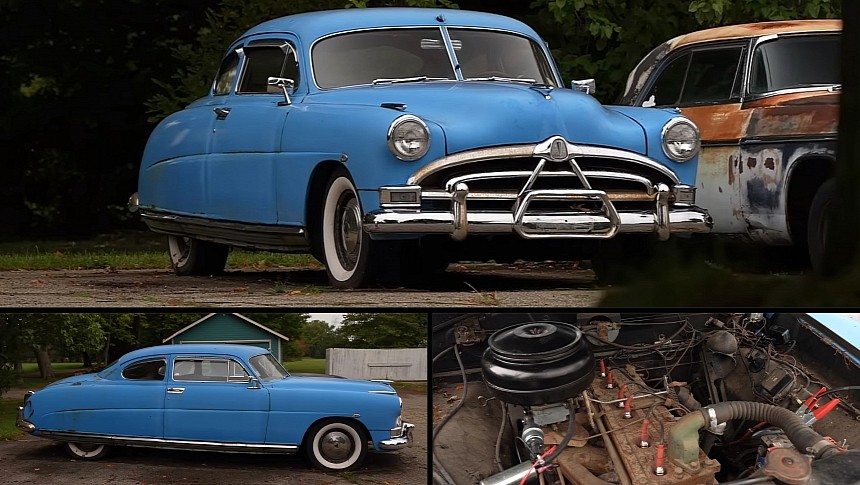Established in 1909, Hudson Motor Company disappeared in 1957, three years after a merger with Nash-Kelvinator. The Detroit-based company is pretty much forgotten nowadays, but it left a few cool automobiles behind. The Hudson Hornet is arguably the most iconic.
Introduced in 1950, the Hornet was built on the "step-down" architecture first seen in the 1948 Commodore. Unlike a unibody, the layout did not fully merge the body and chassis into a single structure. Instead, the floor panels were recessed down between the chassis rails. The architecture became widely adopted later in the 1950s as the perimeter frame.
The "step-down" chassis lowered the car's center of gravity and enabled designers to create a more low-slung body. So not only did the Hornet look more stylish and sleek, but it also offered better handling. It was also one of the most comfortable automobiles of the era, with many comparing it to more expensive Cadillacs.
Powered by a 5.0-liter inline-six rated at 145 horsepower, the Hornet became the car to beat on NASCAR ovals from 1952 to 1954. The mildly modified Hudsons won 66 NASCAR Grand National races in three years, an astounding accomplishment for a vehicle aimed at the premium market. Hudson's involvement in NASCAR helped move more than 131,000 Hornets through 1954 when the car was redesigned and the "step-down" frame abandoned.
But despite its legendary NASCAR status and appearance in the "Cars" film, the Hornet is not quite as desirable as other 1950s classics from the Big Three. This also means that many examples remain abandoned in junkyards as they rot away under full exposure to the elements. The 1951 two-door coupe you see here is one of the lucky ones, having just been revived by Hagerty's David Reckow.
Parked in a yard next to a couple of rusty rigs, this Hornet last touched a public road several years ago. But the car is still in excellent condition, with no significant rust damage visible on the outside. Sure, the blue paint is weathered in places, but the chrome still shines, and the body panels are still straight for the most part.
In short, it's an unrestored survivor that still has plenty of life in it. What's it doing sitting in a yard, then? Well, the old inline-six is no longer running, and it had a few issues when the Hornet was parked many years ago. Fortunately, David knows quite a few things about getting old rigs running again and revived the legendary Twin-H powerplant.
And even though it hadn't sipped gasoline in a very long time, the straight-six not only agreed to run but also had enough juice to take the sleek two-door for its first drive in a long time. That's fabulous news for a fabulous car. Granted, this one did not wear the "Fabulous Hudson Hornet" lettering on NASCAR tracks, but it has what it takes to become a legendary survivor.
The "step-down" chassis lowered the car's center of gravity and enabled designers to create a more low-slung body. So not only did the Hornet look more stylish and sleek, but it also offered better handling. It was also one of the most comfortable automobiles of the era, with many comparing it to more expensive Cadillacs.
Powered by a 5.0-liter inline-six rated at 145 horsepower, the Hornet became the car to beat on NASCAR ovals from 1952 to 1954. The mildly modified Hudsons won 66 NASCAR Grand National races in three years, an astounding accomplishment for a vehicle aimed at the premium market. Hudson's involvement in NASCAR helped move more than 131,000 Hornets through 1954 when the car was redesigned and the "step-down" frame abandoned.
But despite its legendary NASCAR status and appearance in the "Cars" film, the Hornet is not quite as desirable as other 1950s classics from the Big Three. This also means that many examples remain abandoned in junkyards as they rot away under full exposure to the elements. The 1951 two-door coupe you see here is one of the lucky ones, having just been revived by Hagerty's David Reckow.
Parked in a yard next to a couple of rusty rigs, this Hornet last touched a public road several years ago. But the car is still in excellent condition, with no significant rust damage visible on the outside. Sure, the blue paint is weathered in places, but the chrome still shines, and the body panels are still straight for the most part.
In short, it's an unrestored survivor that still has plenty of life in it. What's it doing sitting in a yard, then? Well, the old inline-six is no longer running, and it had a few issues when the Hornet was parked many years ago. Fortunately, David knows quite a few things about getting old rigs running again and revived the legendary Twin-H powerplant.
And even though it hadn't sipped gasoline in a very long time, the straight-six not only agreed to run but also had enough juice to take the sleek two-door for its first drive in a long time. That's fabulous news for a fabulous car. Granted, this one did not wear the "Fabulous Hudson Hornet" lettering on NASCAR tracks, but it has what it takes to become a legendary survivor.










